The problem
- Why do we prefer the electric or acoustic guitar over the electric bass or double bass? Why isn’t it valued in the same way as other instruments?
- For most users, whether they listen to music or not, the bass often takes a back seat because it’s barely noticeable in a song. Its notes are much lower in pitch compared to other instruments, which means its sound doesn’t stand out as much. The primary goal of this personal project is to demonstrate the opposite — that even though the bass may not be heard prominently, it can be deeply felt.
- A significant part of the problem begins with the normalization of drinking more than a glass or two in a day, turning it into a habit rather than recognizing it as a potential health issue.

For more details on this work, everything is documented in this link.
Research & Analysis
I’ve identified the main project objectives:
- Emphasize the importance of the bass in music.
- Enhance information about the instrument, making it more appealing to those interested in learning.
- Change users’ perceptions when comparing the electric bass to other instruments, such as the electric guitar.
To achieve these objectives, the target audience must be as broad as possible. It includes music listeners, individuals interested in learning to play musical instruments, and even those who are already learning an instrument and are curious about the electric bass.
To delve further, we’ve created a quick outline of pain points and goal points related to the issue of the bass:

Key Findings from Desk Research
- Limited information about the electric bass in Spain.
- In countries like the United States, there is much more information available about the electric bass.
- When searching for information about bassists, you tend to find more resources from outside of Spain.
- The way information about the electric bass is presented in Spain is often unattractive and not conducive to learning. I found more information on music forums, although it tends to be more informal. Nonetheless, forums are not the best medium for learning an instrument or finding comprehensive information.
Benchmarking
Apart from searching for information about the electric guitar, we needed to conduct benchmarking on apps, websites, and even video games primarily related to the electric bass. However, we also looked at those related to other instruments that align with the objectives we want to achieve.
- The apps we investigated include Bass Grooves, Realbass, Mybass, Musicians, and Tunebend. These are essentially bass or other instrument simulators with interactive learning features, as well as apps with music theory related to the bass.
- The websites we explored are the Bassists’ School, Scottbasslessons, and Bass and Bassists Magazine. These websites offer online bass guitar lessons and magazines focused on bass.
- Finally, the video games we researched are Guitar Hero and Rocksmith. Both of these video games are available on various platforms and function as instrument simulators where you become part of the music group. This type of video game has generated more interest in instruments like the electric guitar.
There are more apps and websites for simulating playing the bass than for providing general information. Regarding video games, other instruments are much more prominent.
SWOT
To gain a broader context with the information we already have, we quickly conducted a DAFO (SWOT) analysis to better guide us toward the final idea and clarify where to begin ideation:

- This is when I conclude the desk research and realize that what is needed is to provide more engaging, visual, and entertaining information about the bass rather than descriptive text. Why? Because in this digital age, we tend not to read as much as before. The clearer and more audiovisual the content is, the better. Which leads me to the next phase.
Research Questions
The desk research allowed us to generate a large number of research questions through brainstorming. We were able to answer these questions using desk research, surveys, and interviews:

- Thanks to these research questions, I was able to gather more information and design the questionnaires and interviews.
Surveys & interviews
Surveys were conducted with 82 individuals, both musicians and non-musicians, although the majority of respondents were non-musicians and I interviewed two professional bassists, one from Spain and one from the United States, to also compare cultural perceptions. I also conducted interviews with two non-musician users who enjoy music.. The most notable results we obtained were as follows:
Interviews
The bass is the foundation of any song, providing rhythm and depth.
It provides the rhythmic weight along with the drums.
There’s no such thing as a difficult concept; we apply it ourselves.
Depending on the country, there’s greater awareness of the electric bass.
Surveys
There is limited information about the bass guitar.
Negative perception due to lack of knowledge about the instrument.
Difficulty in identifying songs that feature a bass guitar.
Difficulty in identifying Spanish or foreign bassists.
The perception is that it is an expensive and difficult instrument to play.
User persona, empathy maps, and user journey insights
After gathering all the information, we can create user personas and empathy maps for both Carlos and Lucía:


Carlos is a professional bassist who plays in various performances. He is used to his primary instrument, the bass, not being valued too much, and he even adapts by switching to other instruments like the guitar when he has to teach at music schools.
He feels that the bass is much more appreciated in other countries and wants to continue his studies abroad as it would offer more professional opportunities.


Lucía is a pharmacist who is passionate about music. She would like to decide between playing bass or electric guitar on weekends as a hobby, and she’s not sure which one to choose. She feels that playing the electric guitar would be easier since her friends also recommend it, as she doesn’t know much about bass, and because it sounds much better. But she also fears making the wrong choice because she might like the bass much more.
And finally, the user journeys for each one to empathize much more with the user and better understand the issue.


All of this helped me empathize much more because both for the musician and non-musician user, improving general information about electric basses is very necessary. It’s important for Carlos to be more valued as a bassist than a guitarist, and for Lucía to make an easier decision by having the same amount of information about both instruments.
By improving that information, it could reach from the smallest audience to anyone simply interested in music or playing an instrument.
Brainstorming & viability
After the first phase, it was time for brainstorming: what can be done to promote musical culture in Spain regarding the bass guitar?
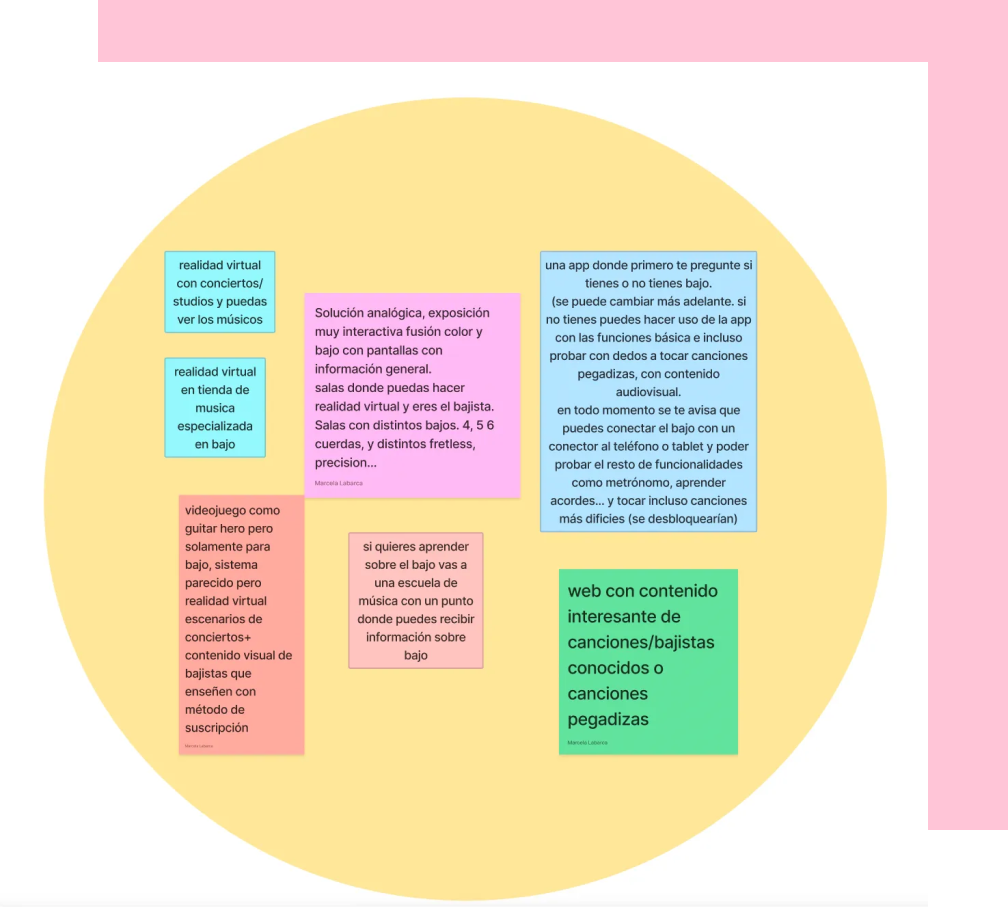
Then, to organize them better, I grouped them within the viability-desirability matrix to make decisions more easily:
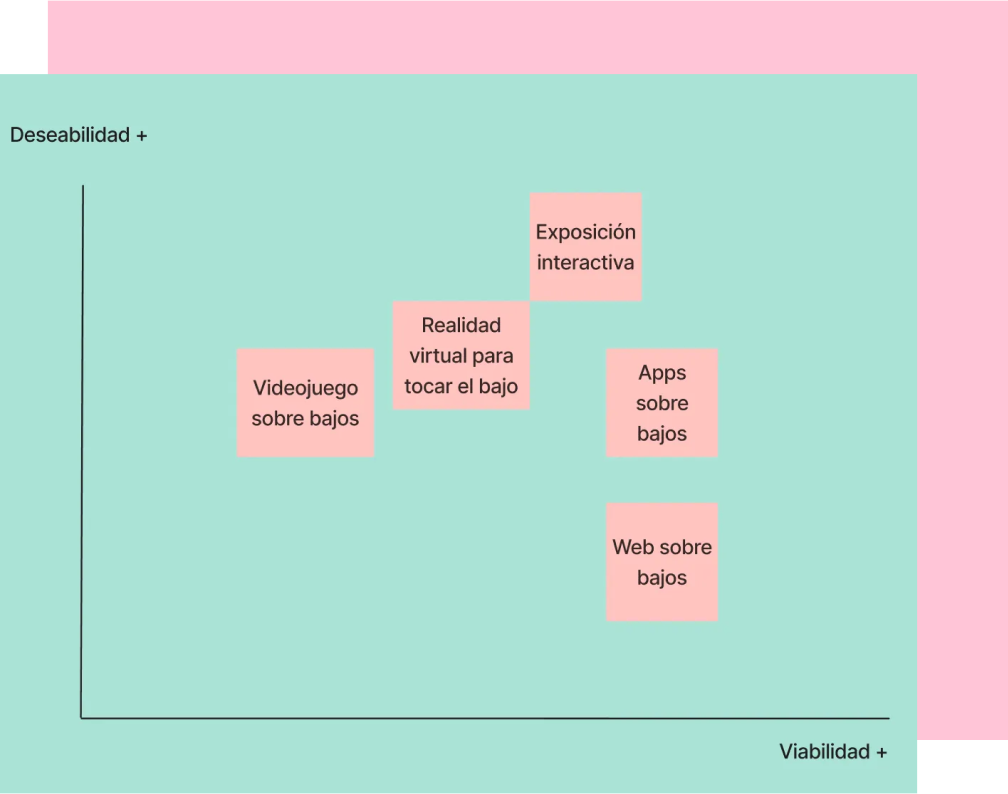
Ideation
Focusing the project based on all the information obtained, the idea had to be as simple, audiovisual, and interactive as possible. During the research, we discovered a relatively recent trend in museums with immersive exhibitions full of color and sound, and as an idea, it was the most suitable for the main objective of the problem. And that’s when the project has its goal set: to create an interactive and immersive exhibition about the electric bass.
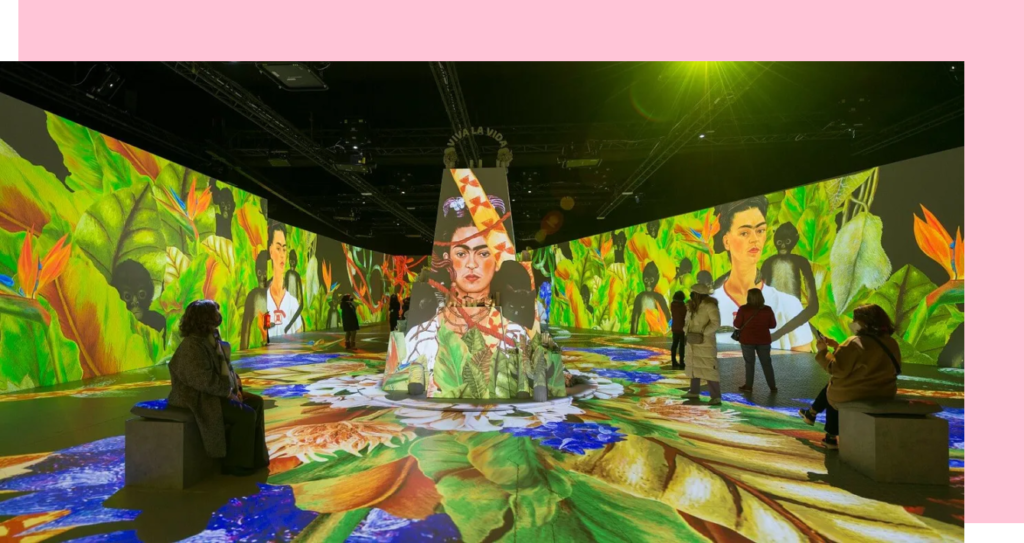
Therefore, both to provide better information about the electric bass and to reach a much larger target audience, from children to adults, in other words, for all possible audiences, it is very suitable for understanding the importance of the instrument as well as having all the basic knowledge about the bass. And even if they want to play the bass, it won’t be difficult for them to decide on one instrument or another.
I also contribute to this idea to give recognition to bassists, as in Spain, they may not be as “well-known” as guitarists. For example, bassists could work there by giving lessons, playing songs, or even teaching, etc.
Product definition
All the details leading up to product ideation (benchmarking, research, insights, business plan, exhibition layout, architecture, etc.) are detailed in the Medium link.
Bassic is a temporary immersive and interactive experience museum about the electric bass intertwined with the significance of color. Here you have what you can find in this museum through web & app:
Visuals
Acta Power for the logo and headings. This font is characterized by the finishes of the characters, which reminded me of musical notes & Aeonik for texts. This is a clear and simple font that enhances readability and legibility.
This color palette—#0667C1 (vibrant blue), #0D0A0C (deep black), and #FFFFFF (white)—is well-suited for a bass-focused app, creating a strong and dynamic visual identity. Overall, this combination enhances the app’s aesthetics, offering a bold and immersive experience that aligns well with the deep and powerful nature of bass music.

Bassic emerged as something very simple and easy to remember. “Bass” in English means both “low” when referring to the “low frequencies” in music and “bass” as in the electric bass guitar. By combining “bass” with “basic” as in fundamental information, the name Bassic was created.
We aim for a simple, functional aesthetic with a touch of color that stands out from the ordinary to resemble the style of exhibition interfaces. We will use shades of blue mixed with black to create a strong contrast.
Museum
Below, I present to you how the museum should be:
Floor 1:
Three interactive bass-playing rooms with immersive color experiences.
Visitors can play real basses positioned horizontally for easy and safe interaction. When a string is played, a song featuring that note begins, and surrounding screens display its associated colors for a sensory experience.
Rotating selection: Three different basses each week, updated on the website.
Shop & Info Room: Music merchandise and history panels, focusing on the electric bass.

Floor 2:
VR Concert Experience: Play bass with any band in a virtual concert.
“Better with or without bass?” Room: Interactive stations to compare basslines and take quizzes.
Workshops & Concerts Room: Hands-on bass lessons with professionals, plus historical displays on bass music.
Food & Beverage Area: Relax in a musical atmosphere.
Guided & Self-Guided Tours: Explore at your own pace or with a guide, with music history and trivia along hallways.
Tickets & Info: Available on the website, including event schedules, room details, and weekly bass updates. Focused on Madrid’s location and audience.
Museum
To conclude, I’ll show you the promotional video of our Bassic museum:
Conclusions and future prospects
To conclude, I’ll show you the promotional video of our Bassic museum:
- Bassic is a project that would have great profitability in the future as it would be a mutual benefit for music companies and musicians, providing audiovisual and entertaining information not only for musicians but for all types of audiences.
- The idea of a temporary exhibition, as mentioned from the beginning, would be because it would be more profitable to go from city to city on certain dates and even internationalize it to make it known worldwide and create a trend of immersive musical experiences that reach the level of recognition of art, which is currently most used in this type of exhibitions.
- If it were to reach a high level of recognition, new rooms for other instruments could even be created, not just for the electric bass, such as the drums, which are closely related to the bass. In fact, the concerts that would be held at Bassic would always feature a bassist and a drummer, as they are the foundation of any song. Additionally, bassists would receive much more recognition both professionally and personally.
- In addition to the mobile-adapted version, I believe it would be interesting to turn it into an app in the future, as it would be more convenient to save a personalized session with options to buy concert tickets, stay updated on which basses are available each week, or who they invite each week to teach how to play. For example, to receive email notifications linked to the app.